This week at ASIS 2016 in Orlando, Hitachi Insight Group launched three news models of its Video Management Platform – the VMP 150, VMP 500 and VMP 1000 – which are optimized for enterprise security environments with the capability to support surveillance deployments ranging from 150 to 10,000 cameras. The company also announced that it is expanding its strategic partnerships with video management software providers Milestone Systems and OnSSI to jointly develop and deliver new solutions to the marketplace.
According to Mark Jules, vice president of public safety and smart city solutions for Hitachi Insight Group, Hitachi has been involved in the video surveillance industry years, providing long-range cameras for border security applications and things along those lines; however, the introduction of these three VMP models officially marks the company’s entrance into this particular segment of the market.
“If we went back five years, you would be hard-pressed to find end-users that were really worried about storing and computer issues around video,” Jules says. “Now, between what’s gone on in the media and things like body-worn cameras, it’s first on everybody’s mind.”
In addition to providing end-users with a fully converged solution that supports today’s most advanced video analytics, Kirill Sokolinsky, director of hardware solutions, smart cities and public safety at Hitachi Insight Group, believes the company’s roadmap will also separate them from the competition.
“What we’re trying to do is bridge the gap between IT managers and security integrators and we want to be the company they go to for a turnkey solution,” Sokolinsky explains. “The other way we’re differentiated is that we support the entire infrastructure, from source layer, the hardware layer all the way to the software layer, but we’re supporting things like virtualization, storage, the video management systems, and things like that so we’re the one-stop-shop for your video surveillance infrastructure needs.”
Sokolinsky says one of the biggest issues they’ve seen in the market are camera deployments built without a real understanding of what video data looks like or how video surveillance infrastructure should be architected.
“For instance, when somebody looks at live video, they’re never really looking at the camera’s live video they’re always looking at the video management system and the VMS is always grabbing that data from storage. We’re trying to architect the system in a way to prevent slowdowns where they shouldn’t be, as well as create high availability and fault tolerance where it is needed,” Sokolinksy adds.
The company plans to go to market through the integrator channel as well as through partners like Milestone and OnSSI.
Justin Bean, director of smart city solutions marketing at Hitachi Insight Group, says that the company has been heavily involved in developing technology for smart city applications but wanted to bring their solutions to a broader market in the private security space and they see their Video Management Platform as a great opportunity to do just that.
“Security is a big concern around the world for obvious reasons and this is fueling a lot of new security systems and a lot of big video growth. On top of that, a lot of enterprises – utilities, manufacturing, retail – all want to gain valuable insights into their operations, their customers’ behavior and things that are happening on site,” Bean says. “Video monitoring and video analytics are coming onto the market and require a lot of high-quality, high-speed and reliable video data. In addition, there are a lot of regulations that are asking companies to have very strong video security strategies and plans, as well as reliable systems that they can use for adjudication of any issues and make sure they are protecting these really valuable assets.”
In fact, IHS projects that the global average of data generated daily by new surveillance cameras will increase exponentially over the next several years, eventually reaching about 2,500 petabytes per day in 2019. From 2015 to 2016 alone, the research firm forecasts that the average amount of data generated daily will increase by 337 petabytes per day.
“That a pretty massive increase. This is being driven by a number of cameras being installed, higher resolution cameras and also longer desired retention of video data and longer archives, larger archive files of that data,” Bean adds.
Hitachi also believes that it can address many of the pain points experienced by end-users with current IP video technology.
“A lot of times the video network is the same as the IT network, so you start looking at video and pulling up those files and that’s going to decrease your bandwidth for other things. That can also lead to blurry video and we’re seeing a lot of customers with lapses in video footage or lost files. We’ve seen customers with their previous systems having up to 20 percent data loss of their video and that has obvious implications for your ability to adjudicate crimes when they happen, to run precise video analytics and video monitoring systems on top of your video data and it’s just a poor user experience in general,” Bean says. “We’re looking to improve a huge part of the user experience.”
To learn more, visit Hitachi at booth #1921 during the show.


